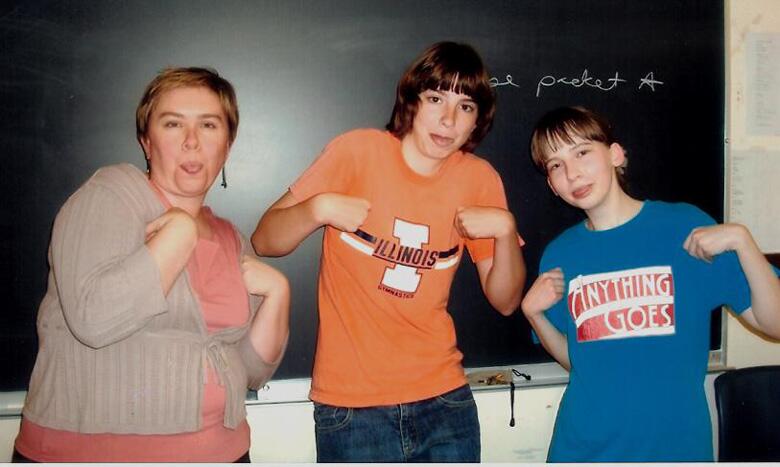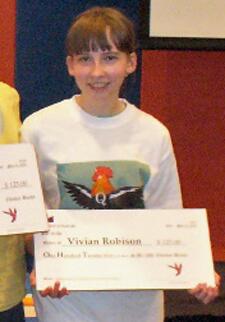
English Teacher Suzanne Linder does the Funky Chicken with award winners Joy Shapley and Vivian Robison
2009 Wylde Q. Chicken Award Winner:
Joy Shapley
Newspeak Translation
English teacher Suzanne Linder submitted this nomination:
Students in all jr/sr special topics courses are asked to write reaction papers. These are generally one- two page papers that pick one aspect of a novel to reflect on and react to. These papers are more formal than a journal entry but less formal than a multi-draft essay.
Joy chose to write her reaction paper on the use of Newspeak in the novel 1984. She wrote a perceptive analysis of Newspeak in Oldspeak but she didn’t stop there. Once she had completed her Oldspeak analysis of Newspeak, she proceeded to translate the Oldspeak into Newspeak, resulting in two versions of the same paper - one two pages long, one one paragraph long.
Joy’s Reaction Paper (in Oldspeak):
Language and Fear in 1984, by Joy Shapley
One of the most memorable aspects of 1984 by George Orwell is the invented language Newspeak, which is full of artificially abbreviated structures and a restricted vocabulary, supposedly to prevent "dangerous" ideas from being spoken. The theory is that, without available words to express themselves in, citizens of Oceania would be totally unable to even think subversive thoughts, let alone to share them with others. Unlike English, which can be interpreted in hundreds of contradictory ways, all Newspeak words have one meaning, and one meaning only.
One other purpose of Newspeak often mentioned in 1984 is its ability to create a kind of mental safety barrier, which cuts off an individual’s train of thought before it reaches the point of no return. Winston refers to this as "crimestop". The moment anything against Party ideology is detected, the simple, pervasive label "crimethink" is attached to it, and that is enough to settle the matter. There are no shades of gray under this definition, because the idea that there can be more than one side to an issue is a purely democratic one. For all intents and purposes, there are only two kinds of thought in Oceania, and each one has a corresponding Newspeak term. "Goodthink", most closely translated as "orthodoxy", refers to blind acceptance of Party ideology and devotion to Big Brother. A "goodthinkful" person is someone who embodies these traits.
In English, badness does not have the same stigma attached to it as there is in Newspeak. The word "bad" was once slang for "cool", and implied someone who cared nothing for authority figures. Our literature is full of romanticized tales of criminals and revolutionaries who are heroes. This is completely impossible in Newspeak. Due to the rigidly defined nature of the language, something which is "bad" can never also be "good", and neither position is a choice. No one can debate morality on the basis of two words, which of course works to the Party’s advantage. They want no argument, no discussion, and no debate, because these things encourage people to think for themselves.
The prefix "un-" also exemplifies this rigid nature. Something which is "ungood" is not even the slightest bit good, no matter how you look at it. An "unperson" was never a person at all. When complex ideas are reduced to simple, meaningless nouns, they become much easier to fit into categories, of which there are ultimately only two: "good" and "crime". There is no need to describe either of these two ideas because anything one needs to know about them is already inherent in the definition. Saying something like "crimethink doubleplusungood" would be obvious, and therefore unnecessary.
Our society today has many examples of proto-Newspeak, in addition to the eerie Department of Defense / Minipax similarity. Politically correct phrases are designed to be inclusive and neutral, to the point where some phrases obstruct the meaning of the original. Unlike in Orwell’s language, the obstruction we see today tends to further confuse and circumlocute the issue rather than control it. However, examples like the substitution of "freedom fries" for "French fries" shows a similar and frightening encouragement of thoughtless patriotism and the demonization of a dissenting "enemy". Thankfully, our society has not progressed yet to the point where such things truly control the way we think and act, but these trends seem to indicate that the possibility remains.
Joy’s paper in Newspeak:
newspeak goodfeel 1984, by comrade joy
newspeak partial doubleplusbellyfeel from readname 1984 writed comrade orwell. from newspeak makeway, now crimethink unpossible, all citizens oceania goodthinkful. oldspeak simple crimethink, contrast newspeak words unvague. newspeakers free of crimethink, antecrimestop 1984 plussaid. ingsoc vers crimethink unfeel oldgov. goodthink define duckspeak partyluv bbluvbellyfeel. citizen goodthinkful with goodthink. oldread crimeluv crimepersons equals comrades doubleplusungood. oldspeak unpossible if good vers bad only. selfthink, ownlife ungood. "crimethink doubleplusungood" unneeded, newspeak simple plusgood convo. oldgov antenewspeak used, defdep equaled minipax, propatria conenemy todaywise. oldsoc becomed ingsoc.
2009 Wylde Q. Chicken Award Winner:
Vivian Robison
Pearlescent Beaded Portrait of Big Brother

English teacher Suzanne Linder submitted this nomination:
My student teacher, Alyssa Bluhm, assigned a fairly traditional response project for 1984. Students were asked to choose a reference to 1984 in pop culture and analyze it for a number of factors. They also had the opportunity to create an original piece of art as a response to the novel.
Vivian made this outrageous beaded portrait of Big Brother that while seemingly domestic, feminine and non-threatening is totally terrifying if you look at it for long. Due to the use of pearlescent beads, it looks like Big Brother’s eyes are following you wherever you go. As Vivian details in her accompanying paper, she was inspired by luggage that her family recently purchased that is printed with eyes. The idea being that the eyes will subliminally suggest that you are being watched and deter any thoughts of theft.
The Portrait:

Vivian’s Written Response:
My original work of art directly references 1984 with a beaded representation of Big Brother. I started with a Big Brother propaganda poster, pixilated the image, and changed the medium from a large inked piece to a small glass one. I think the pixilated effect of the beads makes the image a little harsher, and the metallic color with pastels makes the image more interesting than black on white. I originally created this piece working with the theory that if an item seems to be watching you, you are less likely to steal or tamper with it. Along that line, the suitcases most recently acquired by my family have staring eyes painted on. You are not really being watched, but if you feel like you are, you may act the part. This matches 1984’s use of telescreens and propaganda posters to keep inhabitants in line. If Big Brother’s face can deter thoughtcrime in 1984, perhaps his face can deter theftcrime in 2009. Opening one flap gives a better emphasis on BB himself, opening the other reveals the caption from the propaganda poster. When both flaps are open, the beadwork hangs in the center window, letting light pass through.